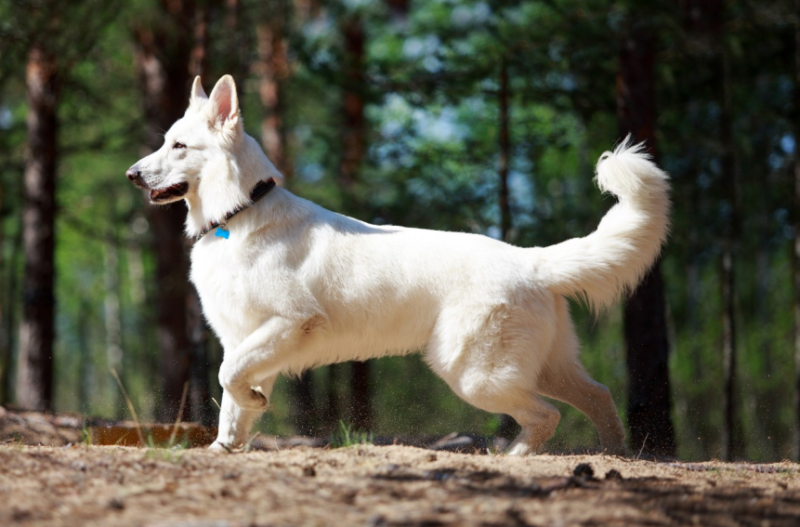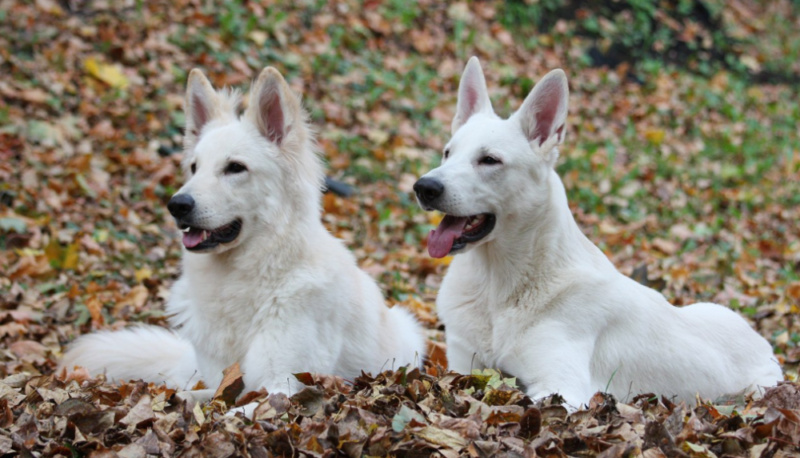Surely everyone at least once in their life thought about making a faithful and faithful four-legged friend. But are there large dogs with a flexible character? Of course! The White Swiss Shepherd Dog (BSHO), which has a keen mind, kindness and sincerity, is a prime example.
Material Content:
Description of species of breed
According to the description of the breed, a parallel can be drawn between the Swiss and German Shepherd (BUT). After all, the first, along with BUT, is characterized as a balanced, obedient, loyal and friendly animal with high intelligence. The main distinctive quality is snow-white wool.
Representatives of the breed are deprived of aggression and get along well in families with children. But despite all their poise, they will not tolerate ill-treatment and will not put up with beatings.
Often in the circle of dog breeders you can hear another name for this harmoniously built dog - the American-Canadian white shepherd. It is connected with the origin of the breed, with the details of which readers will become acquainted later.
Origin history
"Germans" are the ancestors of albinos, which were bred in the 20s. as shepherds of sheep flocks. Farm animals were not afraid of such dogs due to their color and mistook the "shepherds" for their own.
However, after 10 years, the number of breed representatives began to decline, as dog handlers insisted that the white color only spoils the exterior of German shepherds.
If it were not for the emigration of albinos to America, the history of the breed would cease to exist even at the stage of formation.
In the 60s. The breed is widespread in the United States and Canada. Whereas the shepherd became the favorite of Europeans only in the 80s. The year 2002 was marked by the recognition of the MKF breed under its current name. Also at this time, its standards were adopted.
The nature and behavior of the white swiss shepherd
BSO has a perfect temper. Balance and obedience perfectly complements quick wits. Thanks to such a wonderful set of qualities, puppies of a white Swiss shepherd never harm property in the house. If properly educated, they can be left without fear and not be afraid to find a pogrom in him upon returning home.
No outbreaks of aggression were observed for the breed. Even in the presence of a stranger in the territory, they are only wary of a stranger. If the animal feels the danger, then it will first give a voice, and will not begin to attack. In contrast to the “Germans,” the BSO is less reckless, its distinguishing feature is consistency. But the dog should not be active, so you should not confuse restraint with the phlegm inherent, for example, in St. Bernard.
On a note! The bark of the Swiss is not only a signal of threat, but also a way of expressing sincere joy.
Breed standard and puppy selection
The current standard, which must be met by all dogs applying for admission to exhibitions and breeding, was adopted in 2011.
According to this document, BSHO is a medium-sized muscular dog with the following parameters:
- The wedge-shaped head should be proportional to the body, with a clearly distinguishable transition from the forehead to the slightly narrowed muzzle.
- The medium-sized nose is painted black, but lighter tones, including white, are acceptable.
- The teeth form a regular scissor bite.
- High-set almond-shaped eyes are medium in size and painted in dark colors.
- Ears of a triangular shape with slightly rounded tips are set high.
- The medium-length body is notable for its tightened croup and deep chest.
- The limbs of the dog are sinewy and strong.
- The tail is saber.
- The coat can be long or medium, and there are no short-haired white Swiss Shepherd dogs. Both the one and the second species have a slight undulation.
- The color is only white, while the skin is pigmented.
- Growth at the withers varies between 53 - 66 cm (lower values refer to females, and males, as a rule, are much higher).
- Weight - 25 - 35 kg.
In a long-haired white Swiss Shepherd Dog, a “collar” in the neck area, reminiscent of a mane, is clearly visible.
Going for a thoroughbred puppy, which in the future will be able to claim participation in exhibitions, should be accompanied by a specialist, since at an early age shepherd puppies do not possess pedigree characters. In addition, the purchase should be made in nurseries, where you can get acquainted with the pedigree of the future pet.
Important points when choosing a BSHO:
- Place of purchase. Ideally, this should be a nursery.
- Puppy behavior. He must be sociable, contact and active.
- Availability of documents. For future participation in the exhibition, the baby must have a metric with all relevant marks.
- Acquaintance with the baby's parents and their pedigrees.
The importance of the last paragraph is that if the parents are relatives, then a mutation in the offspring is not excluded. This fact is not valid for show class puppies, the cost of which is 1 thousand dollars and more.
Features of keeping a dog
The main feature of the content of the BSO is the presence of significant space. Due to its size, the shepherd is not suitable for maintenance in a small city apartment. The ideal option is an aviary in a country house.
In addition, to maintain the health of the animal, it is necessary to provide appropriate physical activity - running with obstacles, all kinds of weighting materials. Exercises should be daily.
Care, health, feeding
Since the dog has a snow-white “coat”, it will be necessary to pay special attention to it. Because of the color, bathing will have to be done several times a week, or even more often (depending on the weather). Comb out quite weekly, but during the molting period, the frequency of procedures should be increased.
The rest is standard care:
- claw trimming - once every six months;
- cleaning the ears and eyes - as it gets dirty using special lotions;
- treatment from parasites and a visit to the veterinarian, who will conduct an examination and vaccinations - on schedule.
The Swiss Shepherd has good health, but some hereditary pathologies are characteristic of the breed.
Therefore, it is so important to purchase puppies in the nursery, where the buyer will be provided with medical reports on the absence of:
- deafness
- dysplasia
- heart failure;
- mental disorders.
Swiss can be fed with both natural food and super premium class dry feed. In the first case, the menu is much more difficult to compose, but with the help of a dog handler or veterinarian it is quite possible.
The diet should be balanced and include the following components:
- ½ kg of lean meats - daily;
- cereals that do not cause allergies - rice, buckwheat, millet, barley;
- vegetables;
- eggs - three times a week;
- not bony fish;
- dairy products.
Frequency of meals decreases as the pet grows older. So, if puppies eat 6 times before six months, then in the future they will receive food 3 times. Adults are transferred to two meals a day - strictly according to the schedule.
Like the “Germans," the life expectancy of albinos, on average, ranges from 12 to 13 years. The rate may be higher with proper care and feeding.
Destination
This is a service dog breed, its main purpose is to save and patrol along with representatives of law enforcement agencies. In addition, the shepherd has developed a protective instinct, so they can be excellent watchmen. With proper preparation, excellent guide and therapists come out of them. Finally, BSHO is a great companion, becoming an integral part of the family.
Parenting and training
Initially bred as a shepherd dog breed, BSHO is quick-witted and highly efficient. Commands are given to the animal easily. The main thing is to start socialization from an early age: it is necessary to introduce the puppy to the outside world in all its manifestations.
It is recommended to use a soft technique of training based on the encouragement of goodies. From shouts, and even more so the use of force, should be abstained.
The Swiss is able to carry out teams of varying degrees of difficulty. It is preferable to conduct classes in nature, where the animal can enjoy freedom and space.
If you plan to use the dog for business purposes, then, of course, it is better to turn to professionals. The BSO obeys the dog handler without problems and quickly learns a special course, whether it be classes for guides or guards.
Pros and Cons of a White Swiss Shepherd Dog
The American-Canadian white shepherd is graceful and intelligent. She gets along well with people of various age categories. But, like representatives of other breeds, the Swiss has its advantages and disadvantages.
The main advantages of a relatively young breed:
- excellent exterior;
- a full set of working qualities - a shepherd can be both just a companion, and a guard, a police officer;
- high intelligence;
- devotion;
- the complete absence of even a hint of aggression;
- love for children.
Among the shortcomings, dog breeders distinguish:
- constant need for contact;
- regular hair care due to the snow-white color (not only combing, but also frequent bathing).
However, all of the above disadvantages are relatively arbitrary, because grooming and raising in a game form is a small fee for a faithful friend who will never betray, and if necessary, he will give his life for his master.



















